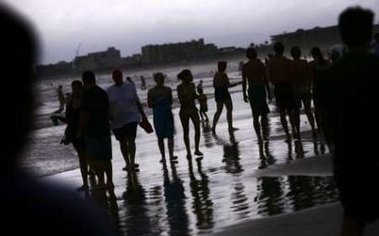NASA has prepared for a new attempt to launch the Discovery shuttle on a
critical mission for the US space program, but nearby thunderstorms threatened
the liftoff again.

People walk at the
beach in Jetty Park in Cape Canaveral while the space shuttle Discovery
sits on the launch pad at the Kennedy Space Center, Florida July 2, 2006.
Bad weather forced NASA to postpone the launch of the space shuttle
Discovery on Sunday for the second consecutive day, with the next launch
attempt set for Tuesday. [Reuters] |
The seven astronauts slipped into their orange spacesuits after ground crews
filled the shuttle's huge external fuel tank for the 3:26 pm (1926 GMT) launch
despite the bad weather at the Kennedy Space Center in Cape Canaveral, Florida.
The five men and two women will fly to the International Space Station (ISS)
on a mission aimed at improving shuttle safety three years after the Columbia
disaster.
But there was a 70 percent chance the weather would force another delay
Sunday after storm clouds scuttled Saturday's launch, said NASA spokesman George
Diller. Apart from weather concerns, officials saw "no constraints" to launch,
he added.
NASA had said that it would skip a day and try to launch Tuesday if Sunday's
liftoff is also canceled. But Diller said the mission management team will meet
to consider launching Monday if liftoff is canceled.
The ISS mission is scheduled to last about 12 days, but NASA wants to extend
it by a day. Discovery has a July 1-19 launch window.
If the launch gets the green light, the astronauts will take critical
supplies to the ISS, perform at least two space walks, and carry out tests on
new equipment and procedures to improve shuttle safety in just the second flight
since the Columbia tragedy.
Columbia's demise was caused by a piece of foam that peeled off its external
fuel tank during liftoff and pierced the shuttle's protective heat shield.
Debris also shed from Discovery's tank in last year's first post-disaster
flight but missed the shuttle. Still, NASA grounded the shuttle fleet until now
to make further modifications to the troublesome fuel tank.
NASA Administrator Michael Griffin again defended his controversial decision
to launch the spacecraft despite concerns expressed by his top safety offical
and chief engineer.
"I had spent an awful lot of time of my own studying the issue very
carefully, because I knew it was going to be controversial, and my analysis of
it convinces me that the chances of damaging the orbiter are quite small,"
Griffin told Fox News Sunday.